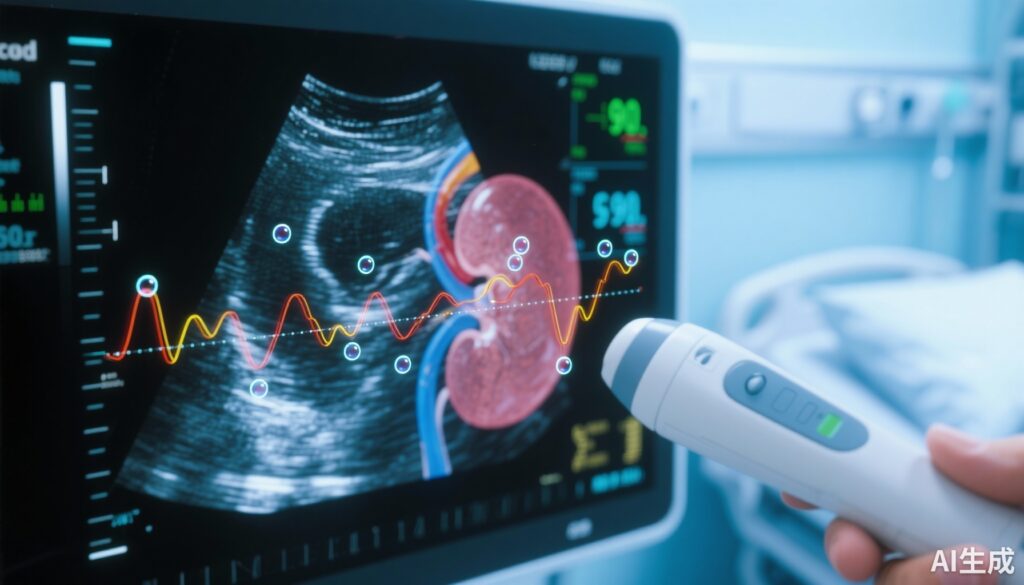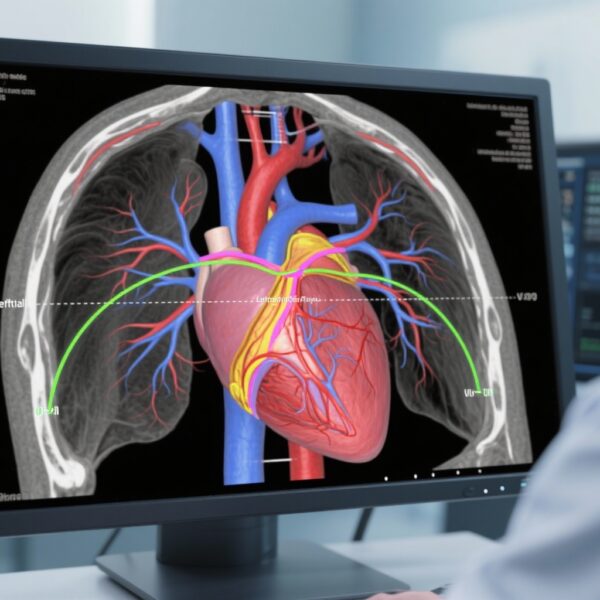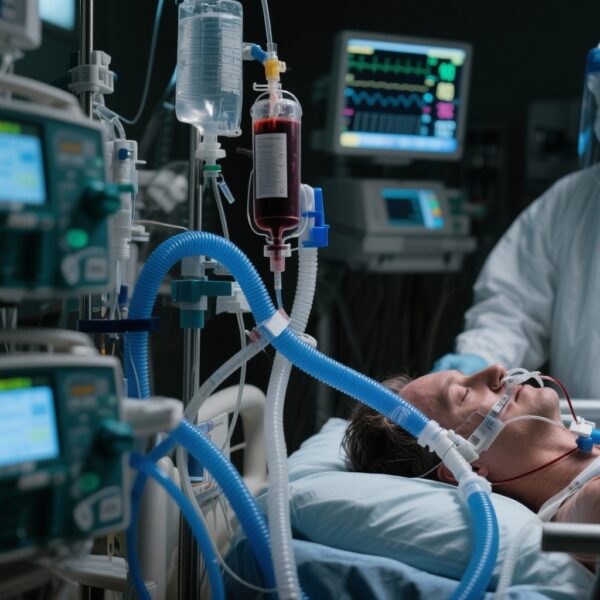Highlights
– In 20 stable critically ill patients, CEUS-derived renal perfusion parameters were stable across repeated scans within one hour.
– Intra-measure coefficient of variation: RBV 23.2%, mTT 13.9%, PI 33.8% — mTT appears the least variable.
– Doubling ultrasound contrast agent (UCA) infusion increased amplitude-based metrics (RBV and PI) but not mTT, suggesting time-based metrics are more infusion‑independent.
Background
Assessment of renal microcirculation at the bedside remains an unmet need in critical care. Acute kidney injury (AKI) is common in the intensive care unit (ICU) and is influenced by changes in renal perfusion at the microvascular level. Contrast-enhanced ultrasound (CEUS) uses intravascular microbubble agents to generate real‑time, high‑resolution imaging of tissue perfusion without ionizing radiation or nephrotoxic contrast. Time‑intensity curve (TIC) analysis of CEUS produces quantitative surrogates of perfusion such as relative blood volume (RBV, an amplitude measure), mean transit time (mTT, a time measure), and perfusion index (PI, a ratio of RBV to mTT). Before wider clinical application in critically ill patients, CEUS quantitative measures require rigorous assessment of their reproducibility and precision under realistic bedside conditions.
Study design
Ma and colleagues performed a prospective observational reproducibility study in 20 critically ill patients who were haemodynamically stable. The cohort was divided into two groups to address complementary questions:
- Group 1 (n = 10): reproducibility across time — three CEUS examinations were performed within one hour under rigorously similar settings.
- Group 2 (n = 10): influence of contrast dose — two CEUS scans were performed: baseline (standard UCA infusion rate) and after doubling the UCA rate.
CEUS-derived endpoints were RBV, mTT and PI. The investigators used linear quantile mixed models to quantify stability across time points, intra-measure precision (coefficient of variation), and the effect of UCA infusion rate. They also explored patient factors associated with CEUS signal instability.
Key findings
Overall stability across repeated scans (Group 1):
- Median values across the three timepoints were similar: RBV 3,289 vs 3,680 vs 3,590; mTT 4.1 vs 4.2 vs 4.2 seconds; PI 684 vs 762 vs 735. No statistically significant differences were observed between timepoints, indicating within‑patient temporal stability over ~1 hour.
- Precision (intra-measure coefficient of variability): RBV 23.2%, mTT 13.9%, PI 33.8%. mTT was the least variable of the three metrics.
- The authors report that a median of five CEUS assessments per patient provided reliable estimates of metrics — implying multiple replicates can improve precision.
Effect of contrast infusion rate (Group 2):
- Doubling the UCA infusion produced a significant increase in RBV (3,207 vs 1,624; p = 0.01) and PI (977 vs 617; p = 0.01). These are amplitude‑based metrics and expected to rise with greater microbubble concentration.
- mTT remained largely unchanged (4.6 vs 3.8 seconds; p = 0.08), suggesting a time‑based metric that is less sensitive to UCA dose.
No patient‑level characteristics were significantly associated with measurement instability, although the sample size limited multivariable analyses.
Interpretation and practical implications
These results provide several clinically relevant insights for use of CEUS to quantify renal perfusion in the ICU.
1. Reproducibility in stable patients
When studies are acquired under tightly controlled and reproducible imaging conditions, CEUS perfusion metrics show good temporal stability over short intervals in haemodynamically stable critically ill patients. This supports the use of CEUS for serial bedside monitoring in research and potentially in clinical decision-making provided acquisition protocols are standardized.
2. Metric selection: amplitude vs time
Amplitude-based metrics (RBV and PI) are sensitive to UCA concentration and therefore to infusion rate, bolus technique, and machine settings. By contrast, mTT — a time‑based parameter — is relatively infusion‑independent and demonstrated lower intra-measure variability. For longitudinal comparisons where UCA conditions may vary (e.g., different operators or infusion pumps), mTT may be the more robust metric.
3. Precision and number of replicates
Measured coefficients of variation indicate that single CEUS acquisitions have non-trivial variability, especially for PI. The authors’ observation that a median of five assessments improves reliability suggests a practical protocol: obtain multiple replicates and report averaged values (or report mTT preferentially if replicates are impractical).
4. Clinical applicability and safety
CEUS has the advantage of being safe in patients with renal dysfunction because microbubble agents are intravascular and not nephrotoxic, making it attractive for patients at risk of contrast-induced kidney injury. However, careful patient selection is needed (e.g., avoid in known severe hypersensitivity to UCA; consult local guidance for severe pulmonary hypertension and unstable cardiopulmonary states). CEUS is bedside-capable and repeatable without ionizing radiation, which suits longitudinal monitoring in the ICU.
Limitations and points of caution
Several limitations temper immediate clinical adoption:
- Small sample size and selected population: only 20 patients, all haemodynamically stable; findings may not generalize to patients with ongoing shock, severe pulmonary disease, or rapidly changing hemodynamics.
- Single‑centre design and controlled acquisition: the study required rigorously similar settings and operator technique — reproducibility in routine clinical practice with variable operators and devices may be worse unless protocols are standardized and staff trained.
- Limited assessment of clinical endpoints: the study was focused on measurement properties not on correlation with clinical outcomes such as AKI progression, renal replacement therapy requirement, or mortality.
- Influence of other technical factors: machine-specific settings (mechanical index, gain), region-of-interest selection, depth, and overlying bowel gas can affect TICs; the study does not comprehensively quantify these sources of variability.
Expert commentary and comparison with guidelines
These findings are concordant with prior guidelines and methodological literature emphasizing standardization for CEUS quantitative analysis. EFSUMB CEUS recommendations advocate for consistent injection protocols, imaging settings, and careful TIC generation to minimize variability. The observation that mTT is less sensitive to UCA dose aligns with the principle that time-based parameters can be more robust across contrast administration differences. The data add an important ICU-specific piece of evidence demonstrating feasibility and reproducibility in a critically ill population, albeit a selected stable subgroup.
Future directions
Key next steps to translate CEUS renal perfusion into clinical practice include:
- Larger, multicentre reproducibility studies including patients with haemodynamic instability and AKI to define generalizability.
- Standardization efforts: consensus on acquisition protocols (bolus vs infusion, UCA dose), ROI placement, and post-processing algorithms to reduce inter-site variability.
- Prognostic studies correlating CEUS metrics (particularly mTT and averaged amplitude measures) with clinically meaningful outcomes (AKI development, requirement for renal replacement therapy, recovery of renal function).
- Technical validation across vendors and different contrast agents to ensure cross-platform applicability.
- Implementation studies to determine minimum number of replicates needed for reliable bedside assessment and to optimize operator training curricula.
Conclusions
Ma et al. provide important evidence that CEUS-derived renal perfusion measures can be reproducible and reasonably precise in stable critically ill patients when acquired under controlled conditions. Mean transit time shows greater robustness to changes in contrast infusion rate and lower variability than amplitude-based metrics, which are sensitive to UCA dose. These findings support use of mTT as a preferred quantitative endpoint when infusion conditions cannot be strictly standardized, and suggest that multiple replicates improve precision for amplitude metrics. Broader validation in larger and less stable ICU populations, and outcome‑linked studies, are required before routine clinical use.
Funding and clinicaltrials.gov
Funding and trial registration details reported by Ma et al. should be consulted in the original publication: Ma H, Frossard P, Gullo G, Trächsel B, Meuwly JY, Schneider AG. Reproducibility and precision of renal perfusion quantification with contrast enhanced ultrasound in critically ill patients: a prospective observational study. Crit Care. 2025 Oct 29;29(1):461. doi: 10.1186/s13054-025-05692-1.
Selected references and further reading
– Ma H et al. Reproducibility and precision of renal perfusion quantification with contrast enhanced ultrasound in critically ill patients: a prospective observational study. Crit Care. 2025;29:461.
– Piscaglia F, et al. The EFSUMB Guidelines and Recommendations on the Clinical Practice of Contrast-Enhanced Ultrasound (CEUS) — Update 2017. (EFSUMB technical guidance for CEUS acquisition and analysis.)
Practical takeaways for clinicians
– For bedside renal perfusion CEUS in the ICU, prioritize standardized acquisition protocols and operator training.
– Favor mTT for comparisons across time or between centres when infusion conditions may vary.
– When amplitude metrics are required, acquire multiple replicates (median five in this study) and average results to improve precision.
– Recognize that current evidence supports feasibility and reproducibility in stable patients; apply caution in unstable patients until further data are available.



